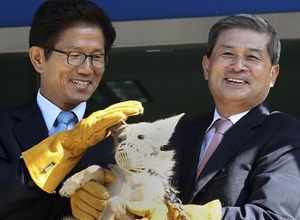
By recovering well-preserved mammoth tissue, like 40,000 year old baby mammoth Lubya, scientists hope to clone the extinct beast and then birth one via an elephant.
According to the agreement, the Russian team will collect biological samples and send them to the Korean team for processing. The Koreans hope to create healthy cell cultures from the tissue as a source for high-quality DNA. The mammoth genome was sequenced in 2008 so they have a quality check for the new samples. Once they have quality DNA, they’ll use somatic cell nuclear transfer – the same technique used to clone Dolly – to swap out the nucleus of an Indian elephant egg with a mammoth cell nucleus. The egg will then be implanted into an Indian elephant for a 22-month pregnancy.
Pretty straightforward, right? Of course not. But if all goes well we could find ourselves studying the extinct animal and learning more about it than we ever thought possible. Not to mention, if they allow it, people will come in droves to see the mythical creature with their own eyes. It would be an historical moment for genomics and recombinant DNA technologies, biology, and science as a whole, capturing the imagination of billions around the world.
The biggest challenge right now is to find tissue and isolate cells that have healthy DNA, undamaged from freezing or radiation produced from the ground. Siberia is an ideal place to search for mammoth tissue. They first emerged in the area 400,000 years ago and flourished up until very recently when they died out at the end of the last ice age about 10,000 years ago. The extent of their reign means that the Siberian tundra is stocked with mammoth remains that are relatively well preserved and thus offer hope that healthy tissue may yet be recovered. One source estimates upwards of 150 million mammoths may be frozen beneath the Siberian tundra. Rising global temperatures are said to be thawing Siberia’s permafrost and making it easier to get to the mammoths. And even though the mammoths were mostly dead by about 10,000 years ago due to a rapidly changing climate and human hunters, a small group still persisted on Wrangel Island in northeastern Siberia as recently as 4,700 years ago. Recovering tissue so recently preserved would increase the researchers’ chances for success.

Disgraced Korean scientist Hwang Woo-suk successfully cloned eight coyotes by implanting their DNA into the egg of a domestic dog
It may come as a surprise to some to learn that the Korean team at the Sooam Biotech Research Foundation in Seoul is headed by none other than disgraced stem cell researcher Hwang Woo-suk. Hwang became famous overnight when, in 2005, he claimed to have created human stem cells from a cloned embryo. He was later found to have forced the women in his lab to donate their own eggs, and then later was found to have falsified much of the data anyway. But it was Hwang’s ability to perform interspecies nuclear transfer that caught the attention of Prof. Vasily Vasilyev, the First Vice-Rector of the North-Eastern Federal University in Russia. As described in a press release, Vasilyev became convinced that Hwang’s lab was the right one for the job after seeing a news report. The work has been verified by other scientists.
The Russian lab was already working with a team of Japanese researchers on the mammoth restoration project but failure to reach an official agreement with the Japanese scientists have led to the Russians shifting partners. Along with Hwang’s lab, China’s Beijing Genomics Institute is also involved in the project.
Sooam said they hope to have restored viable cells by the end of 2012. If that happens and they are then able to implant the clone egg into an elephant, it becomes a 22-month wait to see if the pregnancy works. Given the overwhelmingly bad odds for a cloned and implanted egg succeeding to birth, it seems like a really big gamble to put all your ‘eggs’ in one elephant. But no one ever accused Hwang of thinking small. There’s no telling what he’ll do next if he’s successful in raising the mammoth.
[image credits: Britannica, telecomtally.com and Wall Street Journal]
image 1: mammoth
image 2: Lubya
image 3: hwang


